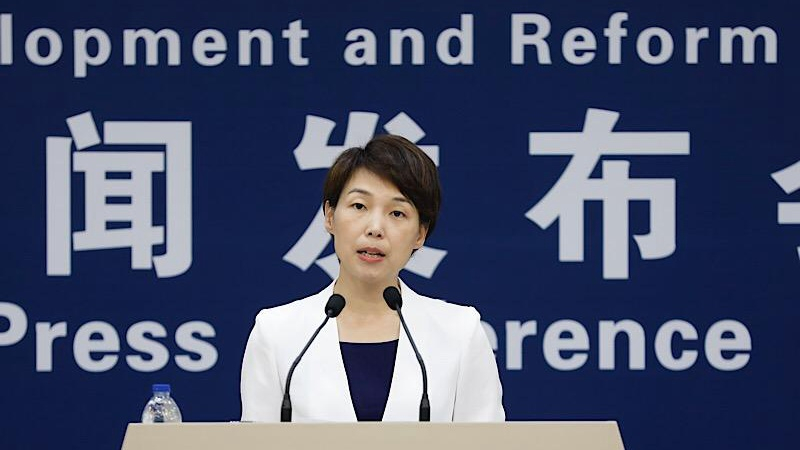

China maintained a steady economic performance in the first half of the year, with good momentum showed in various industries and reforms being carried out smoothly, said the National Development and Reform Commission (NDRC) on Tuesday.
Steady industry growth
China's power generation climbed 3.3 percent year-on-year in the first half of this year, according to Meng Wei, a spokesperson with the National Development and Reform Commission.
In June alone, power generation rose 2.8 percent from one year earlier, up 2.6 percentage points from May, according to NDRC.
China's electricity consumption, a key barometer of economic activity, rose 5.0 percent year-on-year for the first half of 2019, to 3.4 trillion kilowatt-hours.
Specifically, power use by residents increased by 9.6 percent, and that by the tertiary industry 9.4 percent.

VCG Photo
China's natural gas apparent consumption saw steady growth in this year first six months amid the country's efforts to fight against air pollution, with the apparent consumption rising 10.8 percent year-on-year to 149.3 billion cubic meters. The volume of raw coal production reached 1.76 billion tons, up 2.6 percent year-on-year.
China's top economic planner has approved 94 fixed-asset investment (FAI) projects with combined investment totaling 471.5 billion yuan (about 68.6 billion U.S. dollars) in the first half of this year, mainly in energy, high-tech and transportation industries.
Price level basically stable
In general, China's overall price level has remained stable. The increase in producer price index (PPI) has narrowed, and the rise in consumer prices has moderated.
The consumer price index (CPI), in the first half year, rose 2.2 percent year-on-year and the PPI rose 0.3 percent year-on-year.
The food prices index surged 4.7 percent in the first half year, with fruit, vegetables and meat prices among the highest, rising by 16.1 percent, 9.2 percent and 6.6 percent. respectively.
The increase in PPI was significantly lower than the same period last year. Paper and the paper products industry, chemical fiber manufacturing, chemical raw materials and manufacturing, and electrical machinery all witnessed a price decline in the half-year.
Prices of major commodities have generally maintained a stable increase since the beginning of the year.
Supply-side structural reform carried out smoothly
Progress has been made in cutting overcapacity, market-based debt-to-equity swap and cost reduction in the first half of the year.
In the third quarter, relevant departments will continue to carry out inspections on the elimination of excess capacity in the steel and coal fields, and resolutely prevent the resumption of useless production capacity.
As of June 30 this year, Chinese firms signed a total of 2.4 trillion yuan (349 million U.S. dollars) worth of debt-to-equity swap. The capital availability rate has increased to 41.5 percent, with 200 enterprises with high asset-liability ratio being involved.
This year, China announced a slew of cost reduction policies, which has been implemented in a timely pace, including lowering the manufacturing value-added tax rate, further standardizing enterprise-related charges, extending the reduction of unemployment and work-related injury insurance rates, and reducing the average electricity price by 10 percent.
Meanwhile, more financial institutions are encouraged to support small and macro businesses and private companies. Some local governments, such as Zhejiang Province and Chongqing, have introduced new pilot plans in this aspect and major progress has been seen.
Improving social credit system
The state has released regulations to improve the credit repair mechanism, protecting the rights and interests of blacklisted subjects.
Up to the end of June, 36.88 billion pieces of information have been archived on the National Credit Sharing Information Platform. Also, joint punishment for the blacklisted entities has been reinforced, which means they will be limited to purchase the tickets of public transportation, such as flights and trains.
Moreover, the state has enhanced the regulations and governance on thesis and tests plagiarism.

VCG Photo
Given that some companies have relocated their manufacturing and supply chains to other countries, Meng said that this is normal in the process of transformation and upgrading of China's manufacturing industry.
Those companies' decision was made due to several reasons, including exploring the international market and reducing costs. Of course, few enterprises aim to avoid the impact of trade frictions, Meng noted. At the same time, some companies have chosen to return to China because they found it was hard to adapt to the local business environment.
The scale of the relocation is not largely based on the current situation, and it is mainly low-end enterprises, so its impact on China's economic growth, industrial upgrading, and labor employment is generally controllable, Meng added.
According to Meng, the main problems faced by the market are congested channel, high cost, imperfect incentive. and constraints mechanism as well as inadequate supports.
To build a positive business environment, the NDRC announced a reform plan to improve the market entity exit mechanism on Tuesday. This plan offers specific measures including prevention and resolution of overcapacity, elimination of zombie firms, and promotion of the bankrupt system.

Copyright © 2018 CGTN. Beijing ICP prepared NO.16065310-3
Copyright © 2018 CGTN. Beijing ICP prepared NO.16065310-3